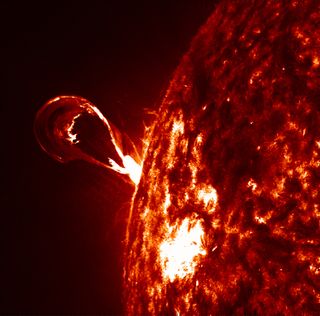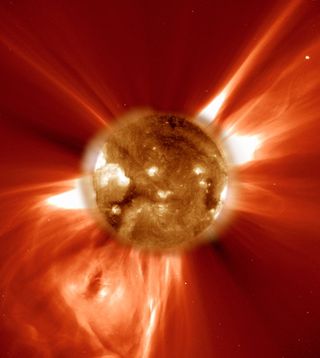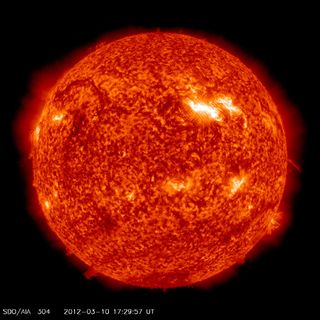Mysteriously Powerful Particles from Solar Explosions Unveiled in New Study

A couple of times a month — sometimes more, sometimes less — an explosion goes off on the surface of the sun, releasing energy that's equal to millions of hydrogen bombs.
Mind boggling as that number is, this tremendous energy output cannot explain how material that is spit out by these explosions gets ramped up to nearly the speed of light. It's like expecting a golf cart motor to power a Ferrari.
In a new study, researchers provide a first-of-its-kind look under the hood of these solar eruptions, taking specific aim at the physical process that accelerates the superfast particles. [Biggest Solar Flares and Sun Storms of 2015 in Photos]
Explosions on the sun
There are currently 18 NASA space missions dedicated to studying our nearest star and its effect on the solar system. Some of these satellites stare directly at the sun almost nonstop, providing a 24/7 stream of images of the sun's swirling, churning surface.
When a solar eruption happens, these satellites also see the incredibly bright flashes of light that are called solar flares. Occasionally, the eruptions also hurl a cloud of extremely hot and electrically charged gas (called plasma) out into space. The expelled plasma is called a coronal mass ejection, or CME for short.

A solar explosion releases roughly the same amount of energy that would come from "millions of 100-megaton hydrogen bombs," according to NASA, where one hundred megatons equal to one hundred million metric tons of TNT.
While that certainly sounds impressive, it's hard to imagine something so enormous. The best way to understand the colossal nature of these events might be to consider an image taken by NASA that shows a particularly massive CME. For comparison, a snapshot of the Earth (to scale) is placed next to this great, flaming ribbon. The planet looks like a daisy in the path of a flamethrower.
Get the Space.com Newsletter
Breaking space news, the latest updates on rocket launches, skywatching events and more!
CMEs travel at roughly 1 million miles per hour (1.6 million kilometers per hour), according to a video from NASA's Goddard Spaceflight Center. But one of the most energetic CMEs ever recorded had particles clocked at over 7 million mph (11.2 million km/h), said C. Alex Young, a solar astrophysicist at Goddard. However, these are what solar scientists call the "slower" particles that are produced during a solar eruption, Young said.
The "fast" particles, usually called solar energetic particles (which are not part of the CME), reach speeds that are near the speed of light — 670 million mph (1.079 billion km/hr). That's more than 100 times faster than the particles in a CME.
These superfast particles can be seen in videos taken by the Large Angle and Spectrometric Coronograph Experiment (LASCO) on the Solar and Heliospheric Observatory satellite (SOHO). LASCO blocks out the light from the sun so it can see the material spewed out by a CME. In these videos, seconds after the cloud of material is seen leaving the surface, white speckles of static fill the screen, sometimes completely obscuring any view of the star. These are the superfast particles colliding with the detector. Similar static storms can be seen by other solar satellites. The static looks like snow, which is apt, because these and similar solar events are referred to as "solar weather." (These videos are sped up in time; in reality, it would still take the superfast particles about 10 to 15 minutes to reach the satellite's detector, Young said.)
But even the sheer force of the solar explosion isn’t enough to explain that kind of bump in energy, Young said. So how do these particles get going so fast? [Solar Flare vs. CME - What's The Difference? | Video]

Shockingly fast
When an airplane breaks the sound barrier — physically overtaking the sound waves traveling in front of it — it creates a shock wave, and a deafening sonic boom. The boom is evidence that the shock wave is a source of energy.
Bin Chen, a researcher at the Harvard-Smithsonian Center for Astrophysics is the lead author on a new research paper that provides the first solid observational evidence that ultraspeedy particles released during a solar eruption are accelerated by a kind of stationary shock wave called a "termination shock."
One of the intriguing elements of solar eruptions is that, unlike most explosions on Earth, they aren't chemically driven. Rather, these sunshine bombs are detonated by a rapid release of magnetic energy. The same force that makes a magnet stick to a refrigerator or makes a compass needle point north is also responsible for these massive belches of light and material.
The solar eruptions that create solar flares and CMEs occur when one of the sun's magnetic-field lines break, and rapidly reconnects, near the surface. During the explosion, plasma is flung out into space, but others go back down toward the surface at incredibly high speeds, where they crash into more magnetic-field loops — kind of like a waterfall crashing into the surface of a pond. At the point of collision, a termination shock forms in the electrically charged plasma.
"Charged particles that cross a [termination] shock can pick up the energy from the shock and get faster and faster. That's how shock acceleration works," Bin told Space.com.

Chen and his coauthors saw evidence of this termination shock during a solar flare on March 3, 2012, using the Karl G. Jansky Very Large Array (VLA) in New Mexico. The recently upgraded telescope was beneficial for two reasons. First, it detects radio waves, which means it isn't overwhelmed by the brightest flashes of light emitted during a solar flare. But looking at a solar flare radio frequencies does reveal the particles accelerated by the termination shock.
Second, the telescope can effectively take around 40,000 images per second. It does this by capturing thousands of radio frequencies at the same time. The frequencies are then separated into individual "images." Chen told Space.com that in order to see termination shock in action, it was necessary to collect that many images for about 20 minutes.
"So if you do the math, that's millions and millions of images [you need] in order to extract the information," Chen said. "That’s a new capability provided by the upgraded VLA."
Chen said the new findings don't necessarily mean that termination shocks are responsible for accelerating particles in all solar flares. He said he and his colleagues would like to conduct further observations to find out if this is the case in all shocks, or only a subset.

The termination shock explanation has been part of the "standard" solar-flare theory for years, but there hasn't been "convincing" observational evidence to back it up, Chen said. Chen's comment was confirmed by Edward DeLuca, a senior astrophysicist at the Smithsonian Astrophysical Observatory, which is part of the Harvard-Smithsonian Center for Astrophysics (DeLuca works in the same department as Chen, but was not involved with the new research.)
"[The new result] reveals that we're on the right track with the standard-flare model," DeLuca said.

Look out for powerful particles
All those NASA satellites studying the sun are not just working to create mesmerizing images; they're also there to help protect Earth. Solar flares and coronal mass ejections pose a hazard to the planet. The particles they eject can damage satellites and solar panels, and could pose a serious threat to astronauts doing spacewalks outside the International Space Station, on the moon or Mars.
They can even cause surges in power grids on the ground. In 1989, a CME caused a blackout across the entire province of Quebec, Canada. [The Sun's Wrath: Worst Solar Storms in History]
The superfast particles are of particular worry, because their high speeds mean they can penetrate more layers of material than their "slower" counterparts. When those particles penetrate a piece of solid-state equipment, they can cause a "bit flip" — which could not only damage the equipment but also change what it does.
"If that little flip of the bit means a computer command that normally says, 'keep taking snapshots of the sun,' instead says 'shut down the spacecraft,' that's bad," Young said. "So a lot of times, if there is a large particle event, spacecraft operators will often put their spacecraft into what's called a 'safe mode.'"
That reaction has to happen fast. Light can travel from the sun to the earth in 8 minutes, so the solar energetic particles can reach an orbiting satellite in about 10 to 20 minutes, Young said. Coronal mass ejections leave a little more time, but a delayed response can mean serious consequences.
For that reason, scientists are trying to get better at predicting when solar flares and CME's will occur and how intense they will be.
DeLuca said the new understanding of termination shock will not, most likely, be immediately useful for improving forecasting of solar explosions. But it is a piece of the solar-flare puzzle, and he said it will be incorporated into "next-generation" solar-weather technology and prediction techniques. It's one more step toward helping humans ride out the solar storm.
Follow Calla Cofield @callacofield. Follow us @Spacedotcom, Facebook and Google+. Original article on Space.com.
Join our Space Forums to keep talking space on the latest missions, night sky and more! And if you have a news tip, correction or comment, let us know at: community@space.com.

Calla Cofield joined Space.com's crew in October 2014. She enjoys writing about black holes, exploding stars, ripples in space-time, science in comic books, and all the mysteries of the cosmos. Prior to joining Space.com Calla worked as a freelance writer, with her work appearing in APS News, Symmetry magazine, Scientific American, Nature News, Physics World, and others. From 2010 to 2014 she was a producer for The Physics Central Podcast. Previously, Calla worked at the American Museum of Natural History in New York City (hands down the best office building ever) and SLAC National Accelerator Laboratory in California. Calla studied physics at the University of Massachusetts, Amherst and is originally from Sandy, Utah. In 2018, Calla left Space.com to join NASA's Jet Propulsion Laboratory media team where she oversees astronomy, physics, exoplanets and the Cold Atom Lab mission. She has been underground at three of the largest particle accelerators in the world and would really like to know what the heck dark matter is. Contact Calla via: E-Mail – Twitter
Most Popular


